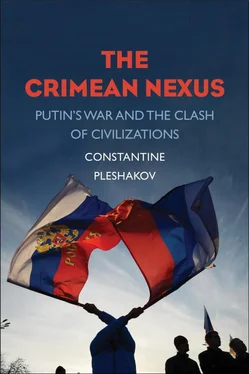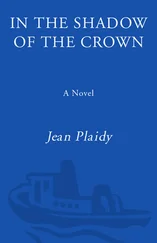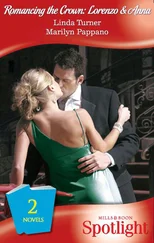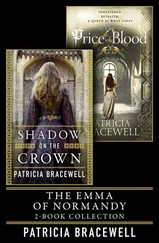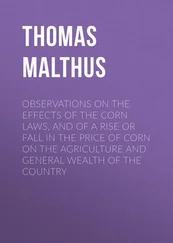This second exodus started in 1860 and 1861. Some 135,000 Tatars left, roughly 40 percent of the Crimean Tatar community. It does not seem that Russian reprisals against the Tatars were gross or consistent enough to cause the flight. Scholars suggest that the general feeling of insecurity made the community “prone to calls for migration” from religious leaders. In other words, social distress manifested itself in religious terms. Tatars leaving for the Ottoman Empire identified as muhajir , Muslims fleeing a homeland occupied by unbelievers to reunite with the Dar al-Islam. [48] Ibid., 156, 173.
For Russian and Ukrainian farmers, the departures were an opportunity. Tens of thousands of Slavs moved into the areas vacated by the Tatars. That should not have been a cause for celebration: Crimea may be fertile, but the chronic lack of water makes it a precarious garden. Experience, knowledge, and skills had departed with the Tatars. One example would be camels: widely and wisely used by Tatars in the arid parts of the peninsula, they were branded “Asiatic” and “backward” by settlers, to be quickly replaced by horses, which were not always suitable for the terrain. “No settler, Russian, Bulgarian, or German, would ever be able to create gardens and vineyards” that perfect “on a terrain foreign to him,” Princess Yelena Gorchakova sighed. Another Russian visitor wrote: “Every person who has spent at least a month in Crimea knows that with the Tatar exodus Crimea died.” Huge areas in the steppes began looking like “the coasts of the Dead Sea,” and the whole of Crimea was like a “house after a fire.” The second Tatar exodus sealed the fate of the peninsula. From then on, the Kirim people would always be a minority in the land of their ancestors. [49] Anna Moskvich, Prakticheskii putevoditel’ po Krymu (Yalta: N. P. Petrov, 1889), 6; Princess Yelena Gorchakova, Vospominaniya o Kryme (Moscow: Tipografiya Obshchestva Rasprostraneniya Poleznykh Knig, 1884), vol. 2, 28; Yevgeny Markov, Ocherki Kryma. Kartiny krymskoi zhizni, istorii i prirody (Simferopol: Tavriya, 1995), 121.
With Tatars leaving and new settlers coming, Crimea was developing as a confusing cultural mosaic, with old landmarks receding or gone, and new ones in the making. In Russian discourse, the empire had defeated “Oriental” backwardness in Crimea through “Occidental” modernization. Crimean towns came to be divided into what was called “new,” or “European,” and “Asiatic,” or “Tatar,” parts. The European neighborhoods faced the sea; the Tatar opening up on the steppes or the mountains. “Nothing of particular interest” could be found in the “Asiatic” parts, a Russian visitor wrote with much contempt, except for the “stillness of Oriental despotism,” represented by walled houses, narrow empty streets, women wearing hijabs, and idle males. [50] Markov, Ocherki Kryma , 122–125; Vsevolozhskii, Puteshestvie, chrez yuzhnuyu Rossiyu , 30–31; A. N. Nilidin, Siluety Kryma (St. Petersburg: Shreder, 1884), 28–29.
Colonization brought modern agriculture, urban development, industry, education, and infrastructure. In 1875, a railroad connected Sevastopol to European Russia, making Crimea a Russian alternative to the French Riviera. The Romanovs built residences on the south shore. Aristocrats followed suit. Resort towns such as Yalta sprang up, and by the end of the nineteenth century the south shore had become the vacation spot for the middle class and the literati too. In 1892, Yalta had a population of ten thousand, and the Baedeker guide called it the “most fashionable and expensive of all” Crimean towns, popular for “sea bathing” and the “grape cure.” Another type of holistic healing, the “mud cure,” with resorts, clinics, and spas, enriched Yevpatoria. [51] John C. Perry and Constantine Pleshakov, The Flight of the Romanovs: A Family Saga (New York: Basic, 1999), 46–47; P. I. Kovalevsky, Yalta (St. Petersburg: Arkhiv psikhiatrii, neirologii i sudebnoi psikhopatologii, 1898), 54, 133–140; Moskvich, Prakticheskii putevoditel’ po Krymu , 160; Karl Baedeker, Russia: A Handbook for Travelers (Leipzig: Karl Baedeker, 1914), 405; Nilidin, Siluety Kryma , 17–21.
A Riviera it could have been called, but with the standards and services of an underdeveloped country. Said one American tourist in the 1910s: “If that place belonged to us, I guess we would make it the beauty-spot of Europe!” [52] Harry de Windt, Russia as I Know It (Philadelphia: J. B. Lippincott, 1917), 184.
Nonetheless, capitalist development brought a print boom, and for colonized minorities the colonizer’s language was a vehicle for accessing contemporary political theory. The anti-colonial Tatar movement in Crimea led to the creation of a party called Vatan, or Fatherland. It remained largely unnoticed by the peninsula’s Slavic majority until 1917.
Just as in Ukraine, in Crimea the Russian revolutions of 1917 brought terror, civil war, and foreign intervention. As the central Russian government collapsed, the Vatan revolutionaries saw a one-off chance to create a national state for the Tatars. Fighting started between nationalist forces and the Red paramilitary units, proxies of Lenin’s government. Neither side shied away from brutality. The bloodbath was brought to an end only by the German occupation in April 1918.
Also as in Ukraine, in Crimea, nationalists, this time Tatar, allied with Germany, and the gambit backfired because they had chosen the losing side in the world war. The fighting that followed after the Germans evacuated at the end of 1918 was worse than what had gone before. The civil war in Crimea was not a bit less horrible than in Ukraine, and for the same reason: while the two major protagonists, the Reds and the Whites, danced a deadly waltz, smaller armies devastated any pockets the big guns missed. [53] Williams, The Crimean Tatars , 339–342.
Reds, Whites, Reds, Whites, each with dreadful “counterintelligence” dungeons; neighbors reporting each other out of vengefulness or paranoia; arrests; appeals to strangers in positions of authority; executions, utter unpredictability, despair. Vladimir Nabokov’s father, a cabinet minister in a short-lived Crimean liberal government, did not have a single good word for the Whites, citing their lawlessness, anti-Semitism, plundering, searches, arrests, confiscations of private property, and random executions. A small Allied force briefly landed in Crimea, but feeling helpless in the face of an unmanageable civil conflict, quickly evacuated. [54] Maksimilian Voloshin, Istoriya moei dushi (Moscow: Agraf, 2000), 309–351; A. S. Puchenkov, “Nabokov V. D. ‘Krym v 1918/19 gg.,’” Noveishaya istoriya Rossii/Modern History of Russia , 2015, #1, 236; M. M. Vinaver, Nashe pravitelstvo: krymskiye vospominaniya 1918–1919 gg . (Paris: Imprimerie d’art Voltaire, 1928); MacMillan, Paris 1919 , 72.
In the fall of 1920, Crimea was the last White stronghold still standing. Among other things, that meant it was the last haven for refugees. When the evacuation from Sevastopol began, “nightmarish because of chaos and panic” according to one contemporary observer, it seemed like the definitive end of the old world. In fact it was. On reaching Istanbul, the White generals immediately started a public fight about who had lost Crimea. Among the survivors of the catastrophe, this debate never ceased. [55] Y. A. Slashchov-Krymskii, Belyi Krym 1920 g. Memuary i dokumenty (Moscow: Nauka, 1990), 131, 211–212.
The Bolshevik revolution was the work of two forces, one destructive, the other creative. As it did everywhere else in the Soviet Union, in Crimea the horrifying terror against the former nobility and bourgeoisie went hand-in-hand with development and social engineering.
Читать дальше
